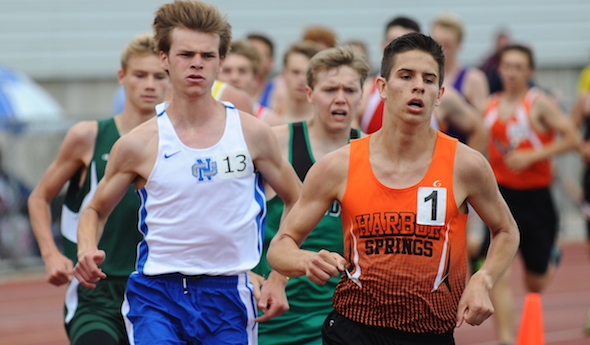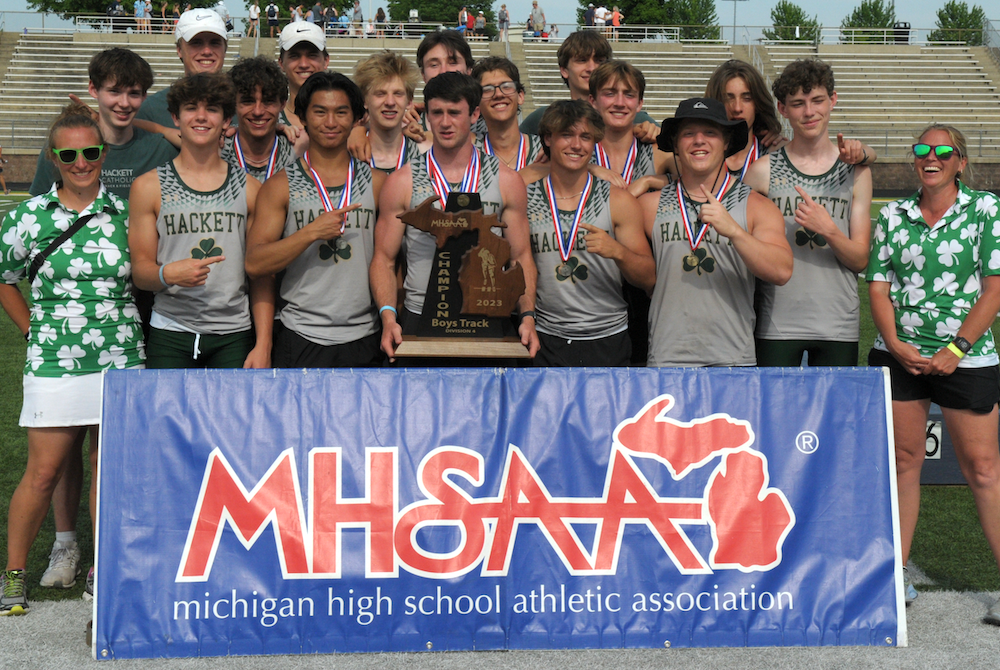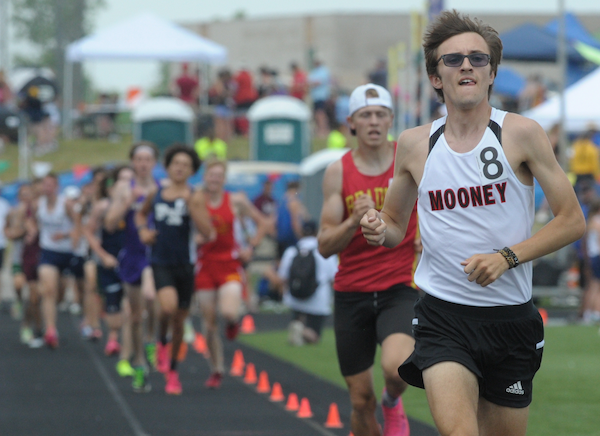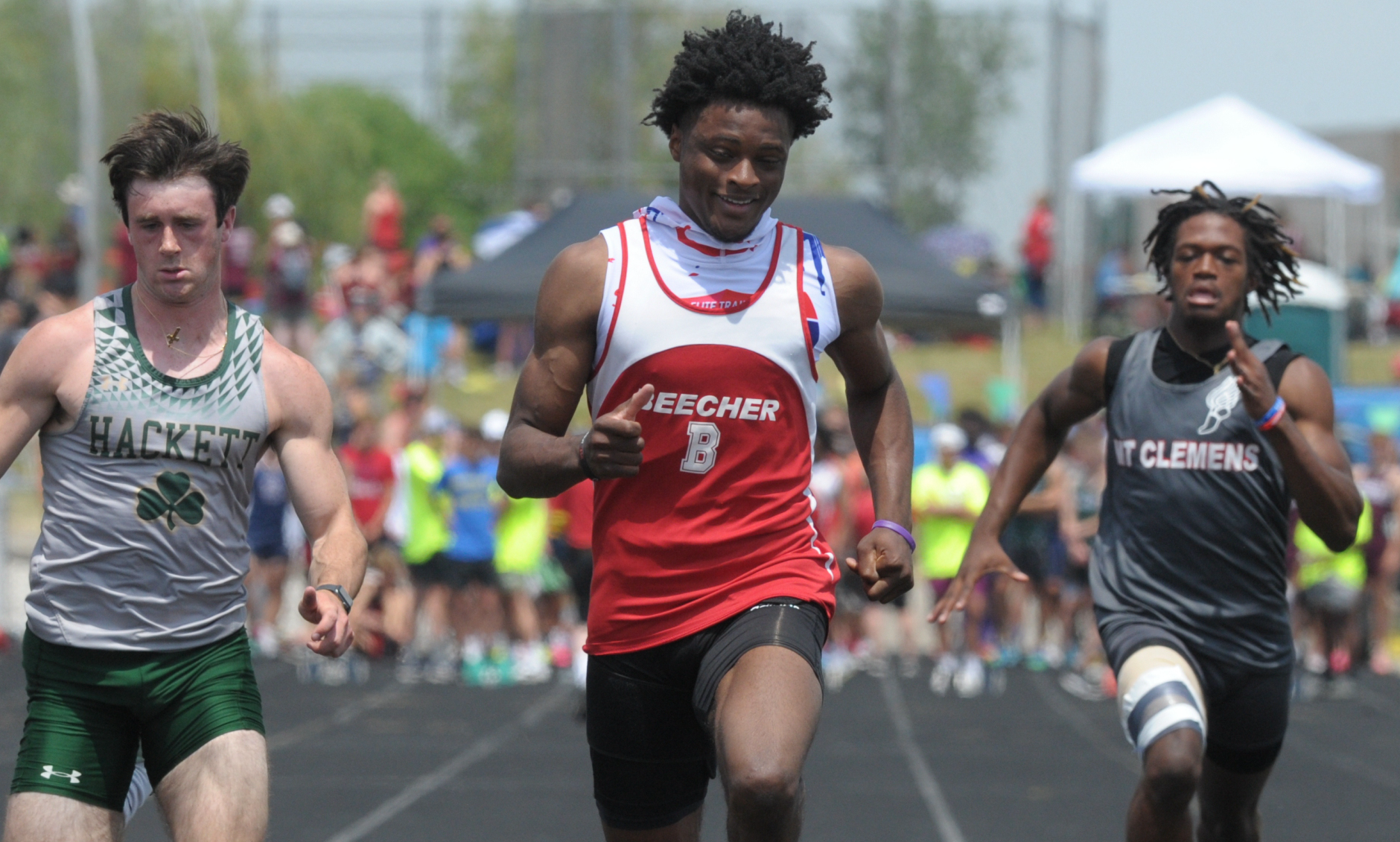
Kloss Raring to Make His Move in D3
April 20, 2018
By Dennis Chase
Special for Second Half
HARBOR SPRINGS – Jeremy Kloss is growing weary of northern Michigan’s cold, snowy spring.
 “I’m a little frustrated,” said the Harbor Springs junior, who won the 1,600 and 3,200 meters at last June’s MHSAA Lower Peninsula Division 4 Track & Field Finals. “I really want to get a meet in.”
“I’m a little frustrated,” said the Harbor Springs junior, who won the 1,600 and 3,200 meters at last June’s MHSAA Lower Peninsula Division 4 Track & Field Finals. “I really want to get a meet in.”
A mid-April snowstorm blasted the area with more than a foot of snow last weekend. Most schools were closed Monday – and some Tuesday.
Kloss used the extended weekend break to put in an eight-mile run – his longest of the year.
“I had to find roads that weren’t as snow-covered as others,” he said. “It wasn’t the best footing.”
No sport has been able to gain traction.
According to the National Weather Service in Gaylord, this is the coldest and snowiest April on record in the northern Lower Peninsula. Some 37.3 inches of snow has fallen in Gaylord this month, eclipsing the previous record of 27 inches in 1923. Traverse City has had 27.1 inches, surpassing the mark of 17.3 in 2007. In addition, the average daytime temperature has been running 18 degrees below normal in this part of the state.
Harbor Springs had its first three track meets cancelled or postponed. The weather is expected to start turning this weekend, so there is hope the season will get underway next week, about three weeks from Regionals.
“I looked on athletic.net and it appears most schools, even downstate, haven’t had too many meets,” said Mike Kloss, Jeremy’s father and the longtime Rams boys track coach. “That makes me feel a little better. If they’re running downstate, and you’re not, then you feel like you’re behind the 8 ball.
“The weather’s got to give us a break.”
Jeremy sure hopes so.
“I don’t know if my mom (Emily, the girls track coach) has taken the snow tires off her vehicle yet,” he said. “I haven’t taken the sand bags out of my truck.”
Once the season starts, Jeremy Kloss is hoping to build off last year’s accomplishments when he set personal bests in capturing the 1,600 (4:25.73) and 3,200 (9:46.25) at the Finals. He was also on the 3,200 relay team that took third and the 1,600 relay that placed seventh. That helped spark the Rams to a third-place team finish.
Kloss, whose three older brothers previously ran for the Rams, jokingly noted last June before the championship meet that his brothers always had one question for him – “Why aren’t you running faster?”
“If you’ve been around us, you know it’s not an easy crowd at times,” said Mike with a laugh.
The 17-year-old put that to rest and now owns bragging rights in the family with the fastest 1,600 and 3,200 times.
Now he’s hoping to keep dropping and challenge school marks in the 800 (Jacques Henning, 1:56.36), 1,600 (Tec Adams, 4:16) and 3,200 (Adams, 9:24).
“My goals are ambitious,” he said. “Aim high.”
“He’s self-motivated,” added his father. “Like (Monday), he went out and ran eight miles in crappy weather. He has big goals in what he wants to do, and that’s what drives him. He wants to be good. He works hard.”
Kloss finished second to Caro’s Yami Albrecht (15:44.7 to 15:47.1) at the LP Division 3 Cross Country Final in the fall. Then, for the most part, he put training on hold to play basketball during the winter.
“Toward the end of the (basketball) season I would wake up at 6 a.m. and run three times a week, and then on the other two mornings I would go to the gym with a couple buddies for workouts (before school),” he said.
All in hopes of getting off to a fast start in track.
Then, Mother Nature intervened.
 Kloss is motivated since he’ll have to now prove himself in Division 3.
Kloss is motivated since he’ll have to now prove himself in Division 3.
“There’s a really good group of (distance runners) in Division 3,” he said. “It’s a tough group to hop in with, but I’m looking forward to the challenge.”
The field includes Albrecht, Hanover-Horton’s Landon Melling, Cass City’s CarLee Stimpfel, Saugatuck’s Corey Gorgas and Kent City’s Fraser Wilson. Gorgas was second (9:20.16), Stimpfel third (9:30.77) and Wilson fourth (9:36.23) in the Division 3 3,200 last June. In the 1,600, Melling finished second (4:17.04), Albrecht third (4:18.49), and Stimpfel fourth (4:19.55).
“That 9:20 Corey (Gorgas) ran in the 3,200 is fast, and I think he ran that fast indoors (over the winter),” said Mike Kloss. “D-3 is a lot different. In D-4 you might have one or two (vying for the title), but in D-3 you’ll have five or six. It’s another challenge, another step.”
In D-4 a year ago, Kloss won the 1,600 by nearly three seconds and the 3,200 by nearly eight.
“I think Jeremy could have gone 4:20 (in the 1,600) in the right type race,” said his father.
East Jordan coach Matt Peterson agrees that Kloss will face a stiffer challenge in Division 3.
“The times will be quicker and the fields will be deeper,“ he said. “But having said that, he was close to winning the D-3 cross country title. It wouldn’t surprise me if he placed very well or won at the state track meet.
“It goes back to his persistence. That’s the one word I would use to describe him. I’ve seen him run since middle school and I’ve never seen him run what I consider a bad race. I’ve never seen him mentally quit in a race, no matter how he feels. Every runner has an off day where they don’t feel right. He runs through that. That’s huge in anything, including life.”
Peterson and Mike Kloss were college teammates at Ferris State in the mid-1980s. He’s watched Jeremy grow up, starting when Jeremy was just weeks old and his parents brought him along to the state cross country meet.
“He’s a nice kid,” said Peterson. “I’ve watched him run at numerous state meets and the way he conducts himself, his attitude, is unbelievable. I was at the D-4 track meet last spring, and after he won the 3,200 he ran across the track and hugged me – and I’m an opposing coach. I can’t say enough good things about him.”
Mike Kloss will let the next few weeks play out to see what events Jeremy will run come Regionals and, most likely, the Division 3 Finals.
“It’s way too early to make those decisions,” Mike said.
Jeremy, meanwhile, is excited to see what the 3,200 relay can do. Senior Max Sydow and sophomore David Harrell return from a unit that posted a podium finish last year. Sophomore Austin Smar will join the mix.
“If we all drop our times, which I think we can, we can be pretty good,” Jeremy Kloss said.
It will be an important few weeks for Kloss as he also tries to showcase his talents for college coaches. He’s received attention from some Division I schools outside the state, although his preference is to remain in-state.
“I would like to be closer to home,” he said.
For Mike and Emily Kloss, this is their 28th year coaching in the Harbor Springs system. They also lead the cross country programs. Mike recently celebrated his 30th anniversary with the Michigan State Police. Most of those years were spent working the nightshift. Now, he’s working days as a court officer.
His training regimen for distance runners is based on low mileage, high intensity workouts.
“It’s not that we went in with that thought,” he said. “We adapted to it. If I ran kids big miles, we would lose them and we don’t have many spares.
“Jeremy has been gradually increasing (his miles), but I don’t want him to run college workouts in high school. It seems to be working for him.”
Jeremy said there’s another benefit to lower mileage.
“Kids are not getting hurt,” he said. “I can’t remember anyone having a stress fracture. The closest thing we’ve had is a couple kids with shin splints for a week or so. We’re staying healthy.”
As a trade-off, runners are asked to test themselves when they do work out.
“My dad likes to say, ‘A little faster if you can stand it,’” Jeremy said. “We have that quote on our sweatshirts and T-shirts.”
Now, if they just had better weather to start applying it.
 Dennis Chase worked 32 years as a sportswriter at the Traverse City Record-Eagle, including as sports editor from 2000-14. He can be reached at [email protected] with story ideas for Manistee, Wexford, Missaukee, Roscommon, Ogemaw, Iosco, Alcona, Oscoda, Crawford, Kalkaska, Grand Traverse, Benzie, Leelanau, Antrim, Otsego, Montmorency, Alpena, Presque Isle, Cheboygan, Charlevoix and Emmet counties.
Dennis Chase worked 32 years as a sportswriter at the Traverse City Record-Eagle, including as sports editor from 2000-14. He can be reached at [email protected] with story ideas for Manistee, Wexford, Missaukee, Roscommon, Ogemaw, Iosco, Alcona, Oscoda, Crawford, Kalkaska, Grand Traverse, Benzie, Leelanau, Antrim, Otsego, Montmorency, Alpena, Presque Isle, Cheboygan, Charlevoix and Emmet counties.
PHOTOS: (Top) Harbor Springs’ Jeremy Kloss leads the pack during last season’s 1,600 championship race at the LP Division 4 Finals. (Middle) Kloss crosses first to win the 3,200 title. (Click for more from RunMichigan.com.)

Thrower Claims Lone Individual Title to Lead Hackett to Team 3-Peat
By
Tom Lang
Special for MHSAA.com
June 3, 2023
Kalamazoo Hackett Catholic Prep just keeps winning and winning.
This time the Irish took home their fourth title in the last five Lower Peninsula Division 4 Track & Field Finals, on Saturday at Hudsonville.
Hackett’s only individual title was taken by discus winner Nathan Buchmann, a senior, who was fine knowing he was the shortest in stature among all the sizable competitors.
“In the offseason after football I worked out every day, working towards this goal,” he said after getting his medal. “I would say this takes 80 percent technique and 20 percent strength to throw the discus. So, length can help but if you have good technique and are really strong, that will play into it.
“I think we are very balanced throughout the meet today,” he said about teammates that scored points in finishes other than first place. “We have 13 guys here today, and we have people in a lot of the races. But I do not run; I have too short of legs to be a fast runner,” he said with a chuckle.
Buchmann had to work through a hip injury to compete this spring.
“I think the setbacks are what make you strong,” he said. “You can either give up through the setbacks or push forward and become better.”
 Coach Charissa Dean agreed.
Coach Charissa Dean agreed.
“The kids have big hearts,” she said after all the points were totaled and the Irish were on top once again, with 53. “They worked hard. They had a lot of potential when we started the season. And we had a lot of drive to put in the work, and we are happy the results came out the way they did.”
Reading was runner-up at 47 points, followed by Wyoming Potter’s House Christian with 42, then Fowler and Flint Beecher each with 37 points.
Senior Lezawe “Moses” Osterink, of Potter’s House Christian, placed second in 1,600 but took the 3,200 title as defending champ of both. He dominated the latter by lapping the field with a final lap kick that resembled more of a superhero speedster.
“Nobody really took it out that hard at the start,” he said. “There was a freshman (Marek Butkiewicz of Hackett) that tried to get the pace going quick, but me and Dakota (Dykhuis of Montabella) just kind of sat back and gradually pulled him through.
“We took it gradually, and I was just relying that I could kick.”
Kick did he ever. The trio were neck and neck the majority of the race in a grouping ahead of the pack.
“With 400 to go I just tried to go all out,” Osterink said. “I had a lot more left than I thought and I was pleased with the win. Not really the time, but that doesn’t matter, especially this hot out.”
The overall meet was in the low 90s/high 80s heat and searing sun all day. So, race officials allowed the unique opportunity for coaches to spray the runners with water and give them water bottles.
“It was very weird because I’ve never taken water to drink while I’m running, so I didn’t know how that would feel,” Osterink said. “And they were spraying us and hitting us in the face. It was kind of fun.”
Junior Tyler Lenn of Marine City Cardinal Mooney defeated Osterink at his own game in the 1,600.
“I’m feeling great,” Lenn said after grabbing the medal. “I said to a newspaper after one of my races (during the season) I was right where I wanted to be. This has been a long rebuilding process for me since an injury back in the fall, and I set a pretty high goal the day the injury happened. I was telling myself I needed to fulfill what I said I would do at the beginning of last cross country season. And that is what I did today.”
Lenn suffered an ankle sprain from a misstep that turned worse because he kept running through the season on it.
“Coming back from that was pretty tough, but I wouldn’t have it any other way,” he said.  “Perseverance; I said from the beginning what I was going to do. I kept my eye on that target, and no matter the circumstances life threw at me, that I was going to make it happen and I am a man of my word.”
“Perseverance; I said from the beginning what I was going to do. I kept my eye on that target, and no matter the circumstances life threw at me, that I was going to make it happen and I am a man of my word.”
Jaylin Townsend, a senior from Flint Beecher, dominated the short races. He won the 100 dash (10.67) and 200 dash at 22 seconds flat. It was his third 100 win at a Finals.
“I put in a lot of work; I had to three-peat,” he said after the 100. “There’s a lot of great competition here, so I knew I had to come out and run my best.”
Concord in the 400 (43.72), Buckley in the 800 (1:30.76) and 1,600 (3:29.13) and Potter’s House in the 3,200 (8:14.18) were relay champs Saturday. Reading’s Tayshawn Bester won the 110 hurdles (15.13), and Athens’ Landen Bennett won the 300 (39.85). Caseville’s Nathan Feltner won the 400 (50.76), and Vestaburg’s Owen Patton claimed the 800 (1:55.11).
Fruitport Calvary Christian’s Bradley Richards won the high jump (6-10), and Peck’s Alex Affer won the long jump (23-4). McBain Northern Michigan Christian’s Isaac Bowden was first in pole vault (13-0), and Brown City’s Kyle Affer won shot put (49-2).
PHOTOS (Top) Kalamazoo Hackett Catholic Prep celebrates its third-straight LPD4 title Saturday. (Middle) Cardinal Mooney's Tyler Lenn, far right, sets the pace in the 1,600. (Below) Flint Beecher's Jaylin Townsend, middle, crosses the finish first for one of his two sprint championships. (Photos by Ken Swart/RunMichigan.com.)

